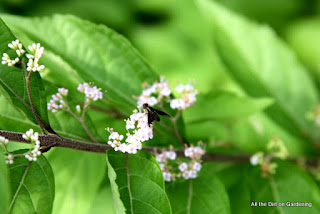Native Beautyberry Shrubs are Callicarpa americana
American Beautyberry shrub is a native, American shrub
in the Verbena plant family. Their native range is primarily in USDA growing
zones 7 to 9. Since they do best in such a narrow range, they have not become a
widely promoted or planted shrub.
Beautyberries are naturalized in moist woodlands
from southern Maryland to NC and from OK to Mexico. When they are planted in colder areas, such
as St. Louis, they die to the ground in the winter.
 |
| American Beautyberry flowers in June |
There are over a thousand other plants in the
Verbenaceae family including all the verbenas, vervains, and lantanas.
American Beautyberry takes its time growing into the
mature size of 3 to 6 feet tall and wide, or more. The summertime flowers are small, pink-white,
clusters that pollinators are drawn to. After the flowers fade the
loose-stemmed shrub has arching stems of mid-green leaves that provide a
backdrop for summer flowers.
In the fall, all of those clusters of pollinated
flowers become clusters of glossy, rose-purple berries (fruit). Since the branch form is weeping, similar to
Forsythia, the berries are displayed in the most appealing way to show off
their shocking color.
Their cascading branching also makes them ideal
candidates for a raised planter, bonsai and cut branches for indoor use. They
also do well under pine trees that have been limbed up enough to allow for sun
and they make good plantings along open fences.
 |
| American Beautyberry seeds October |
They are not vulnerable to any diseases. If the
shrubs are against a solid wall or are planted so close together in a mixed
shrub border that air cannot circulate, scale can become a short-term problem.
The only warning about Beautyberry shrubs is that
they are native plants and as such they are loved by wildlife, including deer.
There will be pollinators in the spring, including
bees. In the summer, birds will be in and around them. The berries are favored
by birds such mockingbird, robin, bobwhite, brown thrashers, catbird and towhee,
as well as armadillo, possum, and raccoon.
American Beautyberry, Callicarpa americana, is easy
to transplant into a wide variety of soil types. In their native habitat they
thrive in moist wooded areas, can tolerate soil that is seasonally wet and dry,
clay, sandy, acid, rich, and calcareous (calcium from rocks and shells).
Like most woodland plants, they will have the
biggest display of flowers and fruit if they receive several hours of sun each
day but do not require full sun to thrive.
Ours are planted with native peach trees that protect them from the
southern sun during the hottest part of the summer.
Try
to purchase Callicarpa americana specifically. Lactea is a hybrid of the
American native that has white flowers and white berries.
The
Chinese varieties, including Callicarpa japonica, Callicarpa bodinieri and
Callicarpa dichotoma can become aggressive, crowding out other plants in the
shrub row. The Chinese varieties are available with white, lavender and purple
fruit. The common names for the Chinese shrubs include Virginia and Profusion.
The
soil provides all the fertility Beautyberries need to thrive and fertilizing
will make them leggy.
Prune
mature Beautyberry shrubs in late winter in order to maintain a compact form.
They can be entirely cut back to 6-12 inches off the ground.
Remove
dead or dying branches but resist the temptation to shape or prune during the
growing season because the pruned stems will sprout new, weak, growth.
You
can propagate Beautyberry in order to have more plants for your garden and to
give away. Simply take cuttings in the spring and plant them in containers.
Callicarpa’s
name comes from two Greek words: kallos (beauty) and karpos (fruit).



Comments